“3D modelling and analysis of biomimetic shark skin denticle-inspired textured coating for the maritime vessel that reduces drag and preventing barnacles”
MECH 6431- Introduction to Tribology- Concordia University
September 2022- December 2022
Problem Statement
Significance of Tribology in the Shipping and Transportation Industry -
The study of wear, lubrication, and friction between contacting surfaces that are in motion is known as tribology. According to estimations, the GNP of developed countries may be reduced by 1.0% to 1.4% by using tribological principles and practices. Here, the transportation and logistics sector, which is more significant as a supplier of industrial raw materials and all commodities, accounts for 7 to 10% of the global GDP and is in charge of keeping all other sectors operating.
90% of global commerce in the transportation and logistics sector is conducted by maritime vessels. More effective vessels can therefore affect the cost of each commodity and good that is transported via them. Without building larger ships, the only option is to go quicker if we want ships to carry our goods at the same rate. And since we want to keep our emissions low, having fuel-efficient ships is essential. And here is where the tribological difficulty enters. [1-5]
Adverse tribological, economical, and environmental implications of unwanted barnacles (marine vegetation) that formed on a ship's hull-
Ships and boats that spend most of their time in the water may have marine vegetation sticking themselves to the hull below the waterline. Ships find it harder to maneuver the sea as a result of the barnacles, weeds, and mussels that have grown on their hulls. Algae and barnacles damage the hull by causing the once-smooth surface to become rougher and by obstructing the flow. As a result, there is a direct drag on the ship. This marine vegetation not only reduces a ship's speed but also allows creatures to enter the hull and harm it. [1-5]
The 10% of the hull that is covered with marine vegetation requires 36% of the fuel energy to be utilized, according to a study on the energy consumption of marine boats. If a slimy layer as thin as half a millimeter covered 50% of a ship's surface, its greenhouse gas emissions may increase by 20–25%.
According to the International Maritime Organization, which is the UN's regulatory body for shipping and the seas, a ship with only 1% of its hull covered in barnacles could use 55% more fuel and produce 55% more emissions. Therefore, the better the fuel consumption, the fewer algae or barnacles are on the hull. [1-5]
The industry now relies on pesticide-based anti-fouling coatings, which are hazardous and can discharge microplastics. These biocides do, however, have an effect on the ecosystem. In addition, the ship needs to be hauled for this maintenance. Even removing a small boat from the water may be costly and put invasive species in danger of spreading over the world's oceans. Include maintenance and non-operating costs, and the business may suffer a significant loss. [1-5]
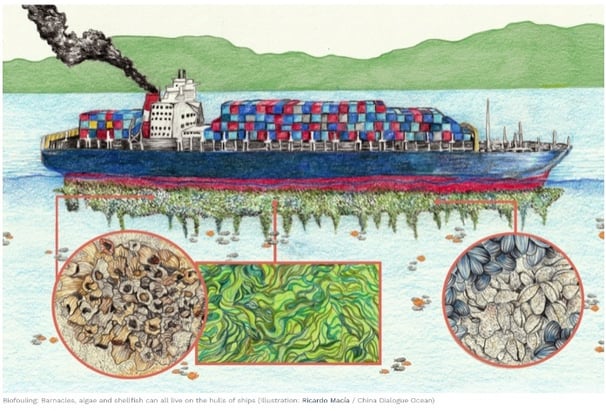


Project Objective
Creating and analyzing tribological textured coating
That prevents marine vegetation (barnacles, algae) from growing on the surface of the hull below the waterline.
That textured coating must be aerodynamic to minimize drag.
Tribological Solution
Tribological surface texturing technology
Surface texturing has been a technologically viable option in recent years for enhancing lubrication, lowering friction, and reducing surface wear. In order to improve tribological performance, surface texturing is a technique that creates micro patterns on the contacting surfaces, such as dimples, grooves, etc. The tasks that textured surfaces may perform, however, are not just limited to those of reducing friction and lubrication, but also of achieving hydrophobicity, reducing drag, and increasing aerodynamic ability. [1-5]
In the current stage of surface texture research, scientists are dedicated to using cutting-edge processing technology to create specific types of patterns and textures on the engineered surface, so as to change its surface properties and make it have particular functions, and various creative applications of engineered surfaces are made possible in a given environment. [1-5] According to conventional tribological theory, smooth surfaces can reduce wear and friction. Researchers have now discovered that biological organisms' surfaces with non-smooth microstructures offer superior surface qualities thanks to the newly involved branch of Engineering called Bio-mimicry (Inspired by nature). [2-5]


Figure 2: Examples of Surface texturing [3]
Selection of surface texturing pattern
Sharks are among the ocean's most swift and nimble fish. In addition to its strong muscles and sleek design, it possesses a special type of skin structure called dermal denticles that allows water to pass through the grooves without swirling and efficiently reduces drag (Fig 3). Replicating that structure and using it for marine applications could enhance its aerodynamic performance.
Figure 6 Does shark skin hold the key to fighting hospital bacteria? - BBC World YouTube Shark denticles' shape may also restrict marine development on the surface (Fig 6).
These intricate patterns have led to the development of several drag-reducing surfaces, ranging from simple ridge-like shapes to complex three-dimensional printed models that precisely recreate the structural intricacy of individual denticles (Fig 4 & 5). The drag has been lowered by 10% when comparing these denticle-inspired surfaces to corresponding smooth control surfaces. [10]


Figure 3- Skin patterns at different areas of shark bodies [9]
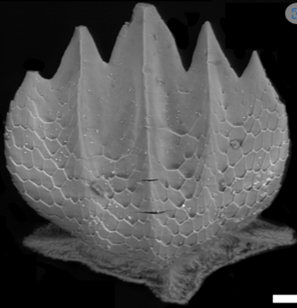

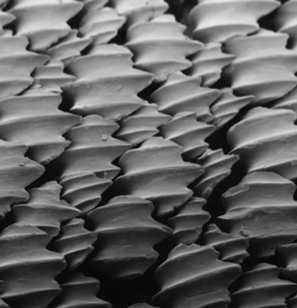

Figure 4- Scanning electron microscope image of a great hammerhead (Sphyrna mokarran) denticle; scale bar = 20um / Photo Credit: Erin Dillon & Jorge Ceballos
Figure 5- Microscopic view of the riblets on a shark’s skin. Picture: Wikimedia Commons
Design and 3D modeling of Shark denticle inspired Tribological textured coating
If you weigh the advantages of shark denticle-inspired textured coating for our problem statement, it could be the best option. In order to study the coating, I thus used Creo 4.0 modelling software to recreate the denticle seen in figure 4 to the 3D model of the Shark denticle inspires textured coating. See figure 5.
The Denticle is 0.4 mm x 0.5 mm in size.
One of the widely tested NACA airfoils is the NACA 0012. Hence, to improve its aerodynamic effectiveness, I constructed the denticle's side view cross section using the NACA 0012 Airfoil's coordinates.
In order to evaluate the layer of textured coating inspired by shark denticles, I have installed the number of 3d denticles on the surface in the manner shown in figure 3 to replicate the genuine Coating.
This almost exact 3D modeled replica of shark skin will be used for experimental investigation and aerodynamic study using the Ansys Software.


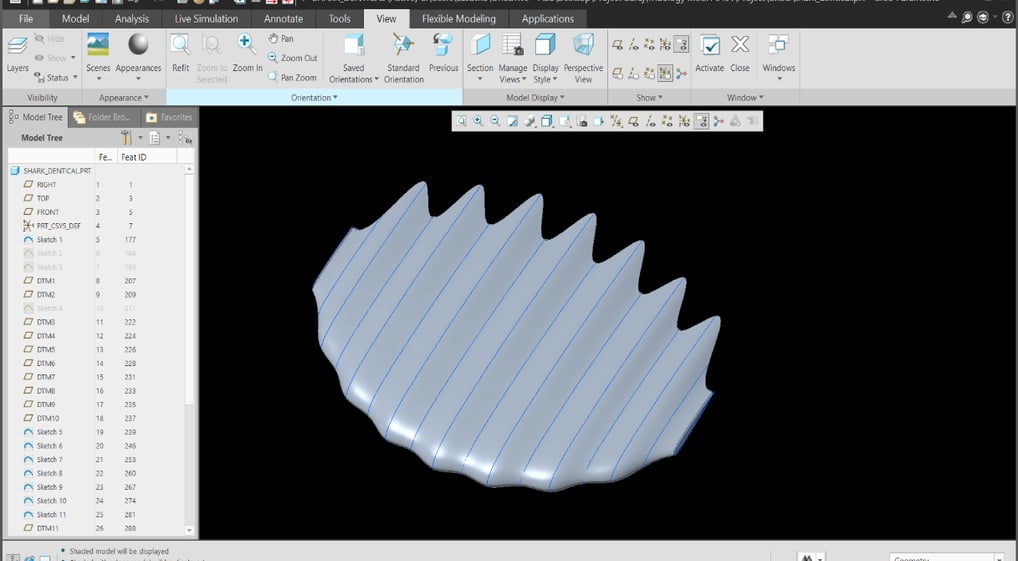

Figure 6- 3D model of single Shark denticle replication using Creo 4.0 software
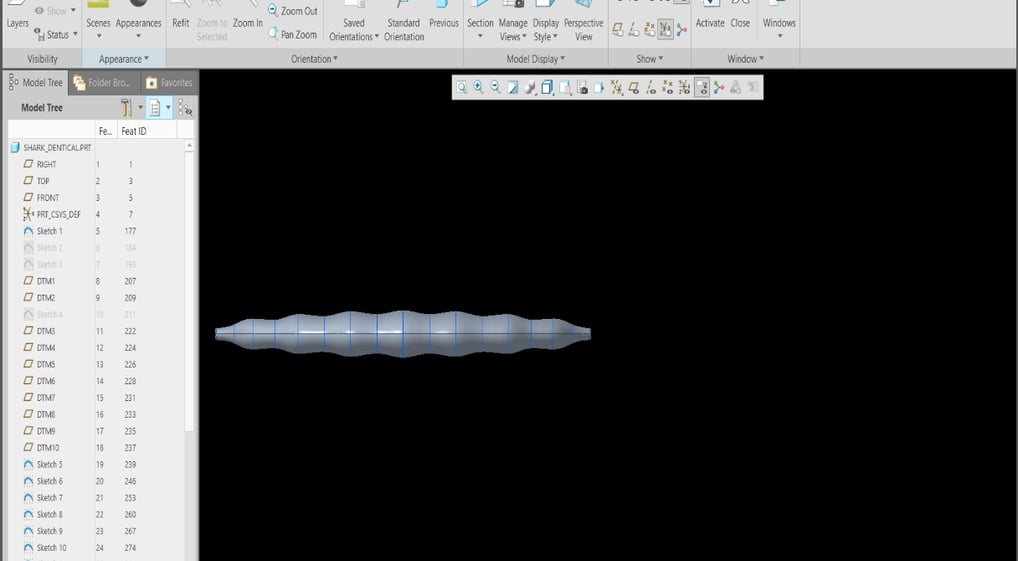

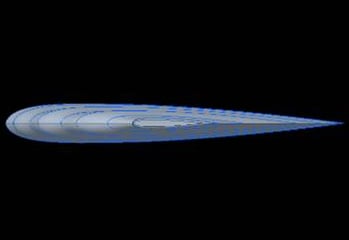

Figure 7- Front and Side View of 3d modelled Shark Denticle


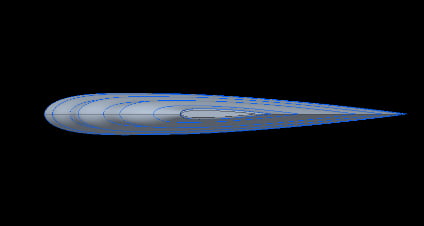

Figure 8- NACA 0012 Airfoil used as a cross section for the Denticle




Figure 9- Shark Skin Denticles inspired coating
Results and Analysis
Project Objective 1- Does this denticle-textured layer, which was inspired by shark skin, truly keep marine vegetation from growing on Hull's Surface?
Sharks are able to withstand fouling aquatic creatures like barnacles and algae. You may see the wavy form if you carefully examine each denticle's front aspect. Barnacles or other marine plants find it difficult to grow on the surface due to the wavy denticle's dip and crest. Sharklet Technology, a firm currently developing a comparable application based on shark skin, can support my hypothesis.
Sharklet is the first invention in history to halt bacterial development only on the basis of the pattern. The form and pattern of a shark's dermal denticles served as the basis for Sharklet's design. Simply because of how it is made, the pattern prevents bacteria Figure 11 Sharklet Technology [6] from adhering to it, colonizing it, or forming biofilms. (Reference- https://www.sharklet.com/) [6]
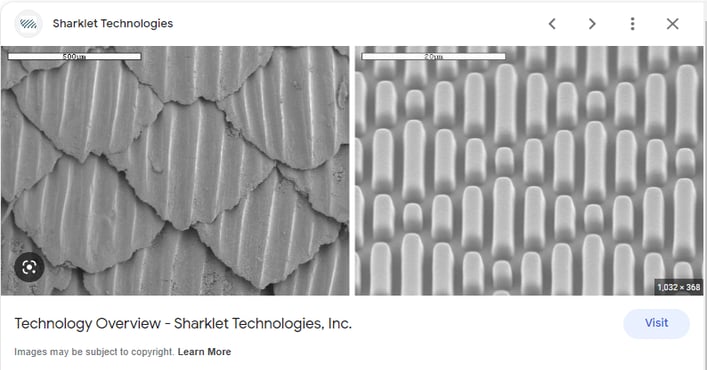

Figure 10- Sharklet Technology
Project Objective 2- Is the texture of its coating aerodynamic in nature?
Ansys CFD Analysis
Most real-world simulations are run using Ansys Workbench. It involves breaking down large structures into smaller pieces, modelling those sections, and then separately testing each one. Once the dimensions of an item are known, various physical properties can be determined, such as pressure, temperature, and Velocity etc.
Ansys CFD is a high-performance computational fluid dynamics (CFD) software that is renowned for its exceptional accuracy, robustness, and speed. Developing and optimizing textured coating can be done quickly and affordably using this software. Thus, it is used here to analyse the Aerodynamic behaviour of coating in order to comprehend how it functions.


Figure 10- Figure 12 Ansys CFD Schematic
Velocity Analysis

Pressure Analysis


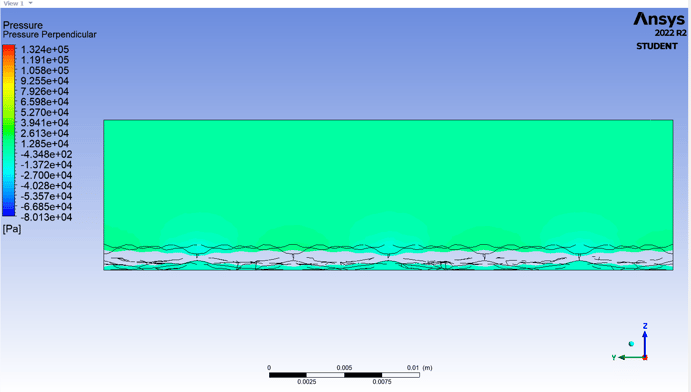




Wall Shear Analysis
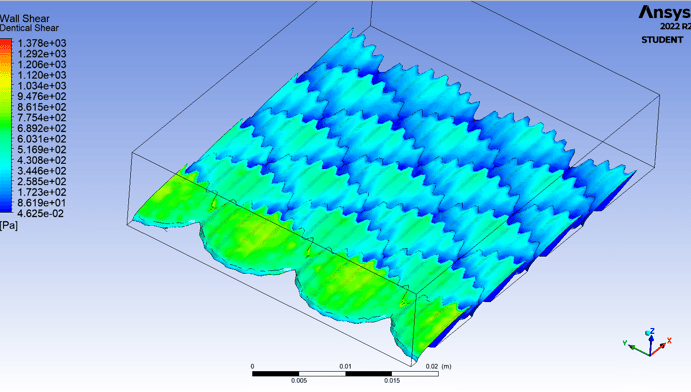

Turbulence Analysis
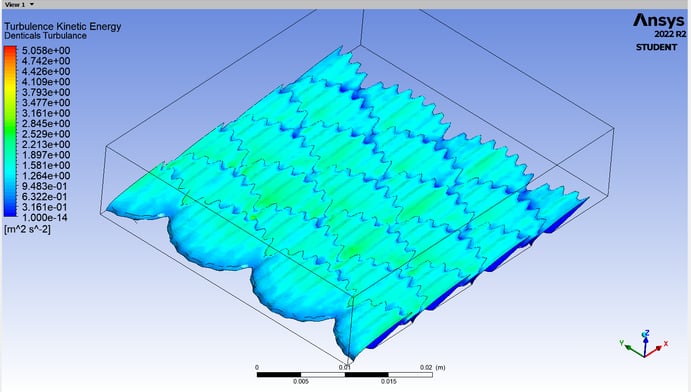

Figure 14 Pressure Contour · Due to its aerodynamic behaviour, the inlet velocity, which is reported as 10 m/s in velocity contour, may reach up to 16 m/s.
In the pressure contour, we can see that there is a vacuum or negative pressure in the space between two dental arches, which makes the coating more streamlined and reduces drag.
Looking at the velocity and pressure contours, we can conclude that the coating's aerodynamic behaviour is quite positive.
In the space between the two denticles, which is represented by the blue colour, there is almost no wall shear or drag. Thus, the total drag has significantly decreased as a result. This is significantly superior to ordinary surface.
CONCLUSION
Shark denticle Inspired textured coating prevents marine vegetation (barnacles, algae) from growing on the surface of the hull below the waterline.
Shark denticle Inspired textured coating is more aerodynamic (to minimize drag) as compared to regular coating.
REFERENCES
Mech 6431, Triblogy Coursework- Notes and Lecture
Climate change: How barnacles and algae on ship hulls are driving up carbon emissions - and the small device that could be a 'game-changer', Sky-News Article https://news.sky.com/story/climate-change-how-barnacles-and-algae-on-ship-hulls-are-driving-up-carbon-emissions-and-the-small-device-that-could-be-a-game-changer-12538527#
Shen, Cong, "Design of Surface Texture for the Enhancement of Tribological Performance" (2016). LSU Doctoral Dissertations. 452. https://digitalcommons.lsu.edu/gradschool_dissertations/452
“Recent development on surface texturing in enhancing tribological performance of bearing sliders”, T. Ibatan a, M.S. Uddin a, M.A.K. Chowdhury.
“Tribological characteristics and advanced processing methods of textured surfaces: a review”, Ze Wu & Hang Bao & Youqiang Xing & Lei Liu
Sharklet technology, https://www.sharklet.com/
L. Ivanović, A. Vencl, B. Stojanović, B. Marković, “Tribology in Industry”, Vol. 40, No. 3 (2018) 448-456
Amy W. Lang, “Physics Today”, 73, 4, 58 (2020); doi: 10.1063/PT.3.4460
Brian Dean, Bharat Bhushan, “Philosophical Transactions: Mathematical, Physical and Engineering Sciences”, 28 October 2010, Vol. 368, No. 1929, Green tribology (28 October 2010), pp. 4775-4806
Domel AG, Saadat M, Weaver JC, Haj-Hariri H, Bertoldi K, Lauder GV. 2018 “Shark skin-inspired designs that improve aerodynamic performance”, J. R. Soc. Interface 15: 20170828
R. Arvind Singh and Eui-Sung Yoon, “Journal of the Korean Physical Society”, Vol. 52, No. 3, March 2008, pp. 656-668 12. Y.F. Fu, et al., “Marine drag reduction of shark skin inspired riblet surfaces”, Bio surface and Bio tribology (2017), http://dx.doi.org/ 10.1016/j.bsbt.2017.02.001


